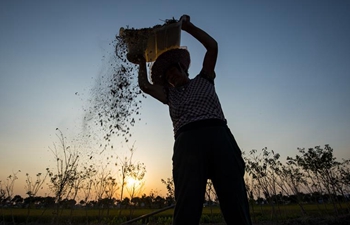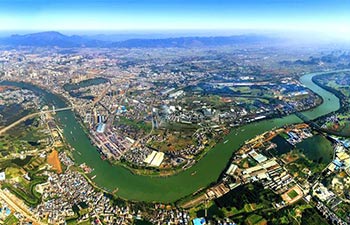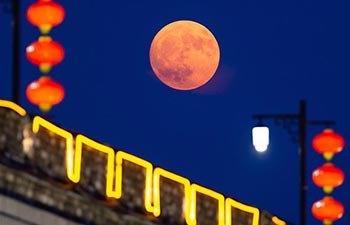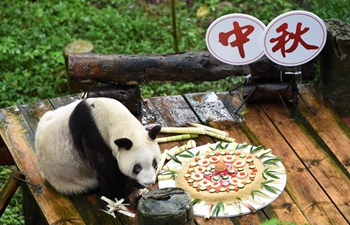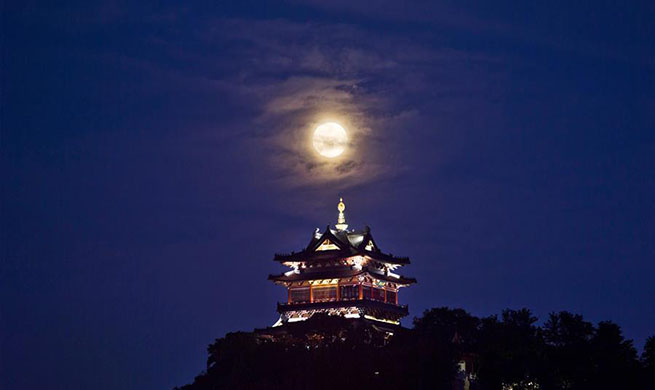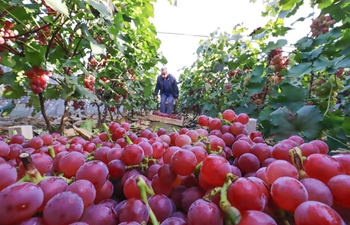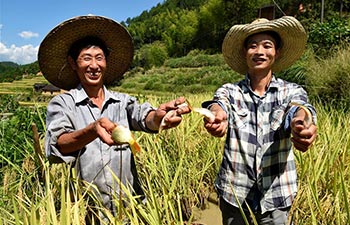by Xinhua writers Cheng Lu and Lu Huadong
CHANGCHUN, Sept. 25 (Xinhua) -- Guide Liu Yiming presses a button while asking: "Are you ready?" Hearing a growling "moo," female visitors exclaim as dozens of bulls suddenly come into sight after the projection screen is lifted.
The bulls, with thick bones, muscular necks, and large and bony heads, stand in a barn separated by a glass wall from the audience. Occasionally their dark eyes cunningly size up the visitors in white jackets.
These are the new beef cattle being promoted by China -- Yan yellow cattle.
"Weighing around one tonne each, the bulls are raised for breeding research and as sources of good quality frozen semen for cattle farmers," said Liu at the bull station owned by Yanbian Animal Husbandry Development Company.
Yanbian, under the jurisdiction of Jilin Province, is the only autonomous prefecture of China's Korean ethnic group.
Cattle, primarily used as plow animals in Yanbian, have now become mouthwatering treats in five-star hotels and soccer clubs in China due to the meat's flavorful taste and unique texture.
FROM FARMLAND TO DINING TABLE
Yan yellow cattle are a cross between French Limousin and Yanbian cattle, a native breed in the prefecture.
The first-generation calf is half French/half Chinese. They were bred with other Yanbian cattle to produce the second-generation calf which is a quarter French/ three-quarters Chinese, according to Liu Chunxi, deputy general manager of the company.
The new beef cattle's ancestor was prominent throughout history.
"In many ways, the history of cattle genetics mirrors human history," he said, adding that Yanbian cattle are a breed that originated in north China. They are closely related to famous Korean hanwoo and Japanese wagyu breeds, having diverged from a common ancestor.
As an important farming tool in the agricultural civilization, Yanbian cattle have traditionally enjoyed a high status.
In the past, they used to share a house with their owners and were offered as rewards to the winner of wrestling matches, which was regarded as the highest honor. In the 1960s and 1970s, it was even illegal to slaughter cattle.
China was the first nation in the world to cultivate rice as a crop. As the biggest agricultural country, it has fed one-fifth of the world's population mainly with crops such as rice.
The reform and opening up launched in the late 1970s have solved food and clothing problems that have haunted Chinese people for thousands of years.
As more machines have been used in agriculture and more money is now in people's pockets, consumption preferences continue to broaden to include less traditional sources of protein, such as beef. Raising cattle in China for meat began to expand.
"More than 60 years ago, it used to be hard for Chinese people to get enough to eat, let alone meat," said Liu Chunxi. "As people's incomes have risen, so too have their food choices. At first, they didn't focus too much on quality, but in recent years, more Chinese are seeking more rich and diverse diets and switching to high-quality beef."
Statistics from the China Meat Association showed that the annual beef consumption in China has risen from 5.69 million tonnes in 2006 to more than 7.95 million tonnes last year.
Although per capita consumption is still low compared to the United States and Australia, China, the world's biggest pork consumer, has seen a growing beef market driven by an ever-expanding middle class.
Since Yanbian cattle have a slow growth rate, Chinese researchers started importing exotic breeds with the smallest genetic differences and began crossbreeding research in the 1980s.
The hybrid cattle maintain the high beef quality of their Chinese parents and have improved productivity.
Set up in 1964, the bull station is home to more than 80 heads of cattle, including Yanbian cattle, Yan yellow cattle and many foreign breeds such as Angus, Simmental, Limousin, and Charolais. Each year, the station can produce 1.8 million doses of frozen semen.
Each bull lives in a spacious enclosure with wooden mats on the floor. Their meals comprise fresh grasses, carrots, and eggs, costing around 120 yuan (around 18 U.S. dollars) per head per day.
Workers lead them to take a walk on an outdoor sports field covered by silver sand after their meal and brush their backs to promote blood circulation every day.
TAKING THE BULL BY THE HORNS
Encouraging farmers in northeast China to apply new technologies and raise new breeds is no easy task.
"The local cattle farmers didn't believe in me, saying, 'you, a witless girl, thought you were more knowledgeable than us only after a few years of overseas study?'" Lyu Aihui, chairwoman with the company, recalled.
To dispel farmers' doubts, Lyu offered them frozen bull semen for free, invited experts to provide on-site guidance on artificial insemination and breeding techniques, and helped many residents cast off poverty.
The cooperation with Marriott, the largest international hotel chain, is a milestone event for Lyu's enterprise.
She met a purchasing manager of Marriott in a sourcing fair in Tianjin in 2010. "I kept writing e-mails to the manager, hoping to increase the presence of our beef in the market," she said.
Months later, she was invited to attend the hotel chain's marketing event. After several rounds of tests, negotiations and site inspection by Marriott and a third-party organization, Lyu won a contract in 2011.
Yan yellow cattle have since then been turned into steak and hamburger patties in more than 50 five-star hotels across China. Most of them are Marriott hotels.
The beef costs up to 200 yuan per kg, around three times that of average Chinese beef in the domestic market.
Sample tests conducted by China Animal Agriculture Association and other organizations showed that the levels of some micronutrients in the company's beef such as manganese, which is essential for proper growth of human bone structure, is higher than those in Korean hanwoo and Japanese wagyu.
In addition to high-end hotels, a local football club is also a prominent client of Lyu's company.
"I found that soccer teams in East Asian countries like Japan and the Republic of Korea that consume premium beef are very competitive," she said.
Thanks to online shopping platforms, the company's beef and processed products including beef jerky can be delivered to more than 500 Chinese cities.
To meet increasing customer demands, Liu Chunxi and other experts are engaged in new research, hoping to increase fetal numbers such as twins.
However, both Lyu and Liu Chunxi have several worries, such as China's expanding beef imports and food safety scandals in the domestic market.
"Our products don't have a price advantage compared with those injected with water and additives to retain moisture on the market. But ours are safer and more nutritious," said Liu Chunxi.
There are more than 600,000 heads of cattle raised in Yanbian. Around a third of them are Yan yellow cattle.
The local government has issued regulations on protection and development of cattle. Meanwhile, cattle loans and insurance have been offered to farmers.
When asked the secret to cattle breeding, Lyu smiled and said, "Different cattle have different personalities. Some are gentle and others can be aggressive. So treating cattle the same as people." Enditem
(Dai Chao, Yu Pei, Zhang Boyu and Gao Nan contributed to this report.)




